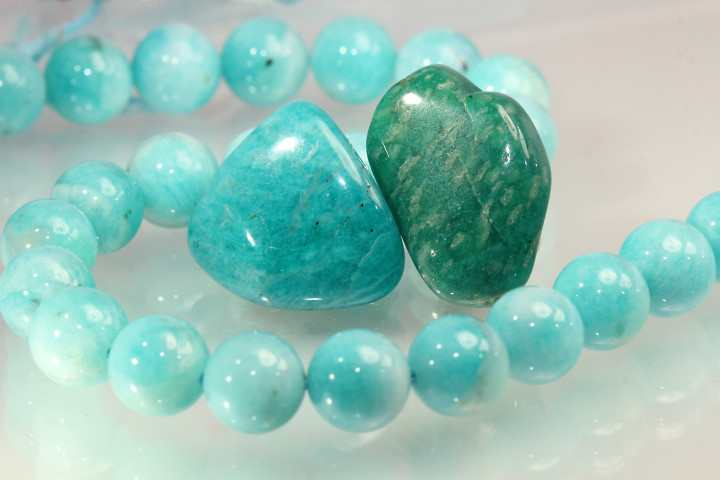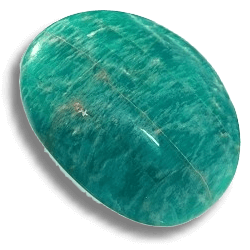
The color of amazonite feldspars differs, depending on disturbances in the crystal lattice
Image: K. Sieber, www.makrogalerie.de
According to the outdated classical definition Amazonite is a microcline feldspar, in green, light or sky blue, bluish-green, malachite green to turquoise colors. It belongs to the group of potassium feldspars (see also our article Feldspar: Like the Sun and the Moon).
The color in Amazonites is based on a low content of lead (Pb-Pb)3+- color centers, activated by natural radioactivity under the catalytic influence of structural water. The maximum color center concentration was detected in the Precambrian amazonite pegmatites of Keivy (Kola Peninsula), which were exposed to natural radiation over a period of billions of years. The individual shades of color depend not so much on the amount of lead but rather on the extension of disorder in the crystal lattice. Amazonites with high Al/Si disorder are usually green and those of low or without disorder are usually blue.
The color of amazonite can increase, decrease, or remain the same when artificially irradiated with gamma rays. Well known, but unexplained so far, is the phenomenon that in orthoclase amazonites from Broken-Hill (Australia) the emerald green color intensifies as soon as they are exposed to the sun for some time. On the other hand, all amazonites lose their previous green or blue coloration when heated. The faded color can be partially restored by irradiation.
Since the 1970s, more and more green to greenish-blue feldspars have been discovered that bear the same or similar characteristics as the classic microcline amazonite, but are not composed of microcline and thus do not match the classic definition. For example, "amazonites" from the famous Brocken Hill (Australia) and Mogok (Myanmar) deposits have been identified as orthoclase, and the green-white patterned amazonites from Mozambique have been identified as microcline feldspar. It segregated white albit feldspar and is therefore named "microcline perthite" in mineralogy. Based on these new findings,the classic definition has more and more expanded over the past 30 years.
Nowadays many scientists propose to extend the term "Amazonite" to all similarly colored feldspars, provided that typical (Pb-Pb)3+ color centers are detectable. Since the potassium feldspars Microcline, Orthoclase and Sanidine form a solid solution series with the sodium feldspars (with Albite as an end member) and to a limited extent also with the plagioclase feldspars (Anorthoclase, Oligoclase) there is a trend to label all blue to green, lead-bearing varieties of the feldspar group with the addition "- amazonite", e. g. Microcline amazonite, Orthoclase amazonite, Albite amazonite, Perthite amazonite, etc. In modern time, there is no longer only one "amazonite", but a multiplicity of chemically different feldspar amazonites.
read more on this topic:




